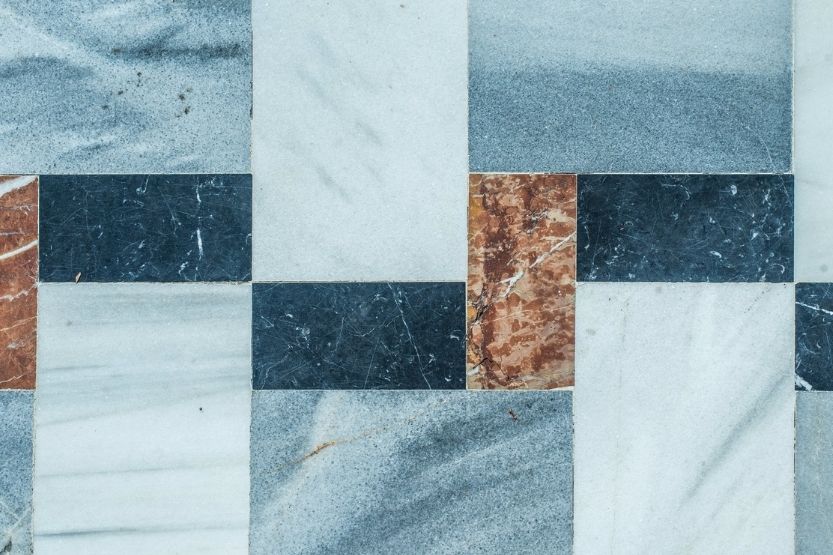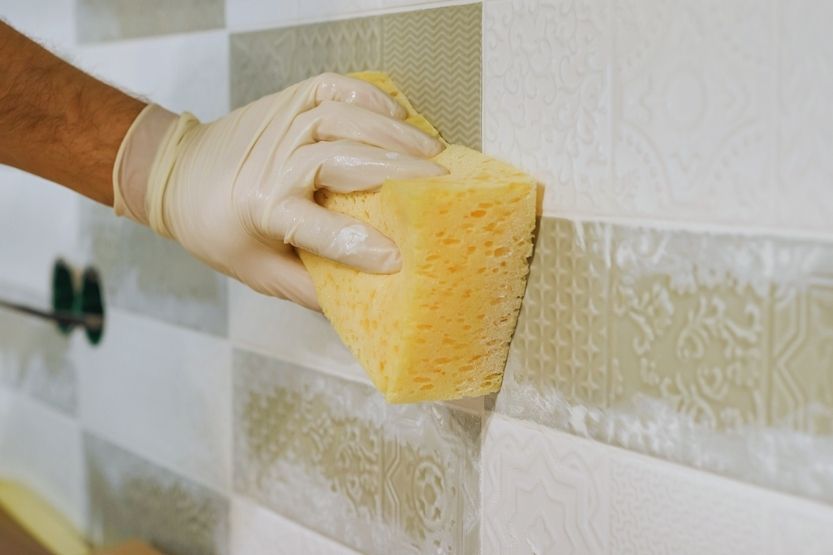Are you planning on replacing the tiles in your kitchen or bathroom? If so, you probably wonder how long it takes for grout to dry.
For grout to work the way it should, you need to let it dry for a day or so. If you don’t, all the effort you put into it will all be for naught. Typically, it will take one to three days for the grout to dry. However, several factors can affect how long it will take for grout to dry completely.
Read on to learn how long it takes for grout to dry and what you can do to hasten the process.
How Long Does It Take for Grout to Dry?

After you finish spreading grout on your tiled floor, you need to give it enough time to dry. It should be completely dry before you or other people in your household walk on it. Stepping on the tiles before the grout has enough time to dry and cure can ruin all your hard work. So, how long for grout to dry?
It might be tempting to walk on your tiled floors immediately after grouting them, but I strongly advise against it. Typically, you need to let the grout dry for at least 24 hours. This should depend on the instructions in the grout packaging.
How Long for Grout to Dry Before Sealing?
The next question is how long for grout to dry before sealing. You will need to wait even longer as you need all the moisture in the grout to dissipate. This might take up to 72 hours.
Factors That Affect Grout’s Drying Time
Brand of Grout Can Affect the Drying Time
As mentioned earlier, the brand of grout can also affect the length of time that it needs to dry. You will need to provide the grout with more than enough time to dry. That said, you should check the instructions on the packaging and follow them closely.
You should clean up all that excess grout while still in the drying stage. Note that grout is strong and long-lasting. It will be very difficult to wait until the grout is dry to clean it off. There is even a risk for you to damage the tiles.
You will need to wipe off the excess tile grout after letting it sit for 15 to 30 minutes. Wipe off all the excess grout that you can find. Do it until the only thing left is a thin haze on the surface of the tiles. You can deal with this easily later after the grout completely dries.
Humidity
Environmental factors in your home can also affect the drying time of your grout. Of all these factors, humidity plays the largest part. If there is too much moisture in the air, it will take longer for the grout to dry. The humid air will add more moisture to the grout rather than pull it out.
Humidity will be an issue if you live in an area where the air can get quite balmy at times. This will also happen if you are grouting an area with many indoor plants. Most people are not aware that plants release moisture into the air, which increases humidity.
One way to ensure that the grout dries properly is to place a dehumidifier inside the room. This is so you can pull the moisture out of the air. Also, placing a fan in the room can help because it will circulate air over the surface of the tiles. This can make the grout dry more efficiently.
Can You Not Use Grout on Tiles?
Can you install a tiled floor without using grout afterward? Well, you can, but you should not do it. Why is it necessary for you to use grout on any tiled floors or walls?
Manufacturers of floor tiles make them in relatively consistent sizes. The majority of them all look identical. This makes newbies at flooring installation think it’s better to lay down tiles without putting grout lines between them.
Many also argue that grout-less tile installations look better. The reason is that it makes the finished product look more compact. However, experienced builders will strongly advise against going down this route.
Why Do You Need to Use Grout?

Most tile installers hate that they have to apply the grout after laying down the tiles, and rightfully so. Applying grout takes a long time and requires tedious and meticulous work. Moreover, there are times when not putting grout lines makes the resulting floor look better.
However, if you want your walls or floors to last a long time, you need to apply grout. Not using any grout will mean the tiles will have a higher chance of breaking. This means that you will need to replace the tiles often. In worst-case scenarios, you might even need to redo the tiles from the start.
Here are some of the reasons why you need to use grout:
1. Tiles Are Not Perfectly Identical
The tiles might look the same, but they are not. The tiles have many minuscule differences; most are not even noticeable. However, even the smallest imperfection can interfere with the installation process.
Those tiny differences will surely add up the more tiles you lay down on the substrate. By the end, you will notice that the tiles look crooked. There will also be many gaps, especially as you get farther away from your starting point. After spending hours on your knees laying down tiles, the last thing you want to see is uneven gaps between them.
On the other hand, you can use grout to mask the differences between the tiles. Even just a small grout line can compensate for the differences in size between two tiles. This can make the finished product look symmetrical.
2. Prevents Dirt and Debris from Getting Caught Between Tiles
Grouting is necessary, whether tiling the entire kitchen floor or the guest bathroom. If you don’t, all sorts of dirt and debris will find themselves caught in the gaps between tiles.
It does not matter how skilled you think you are in laying down tiles. It is impossible to make a perfect seal between tiles. As such, dirt and dust will always find a way to get in between the gaps of your tiles. This can ruin the look of the final product.
3. Prevents the Tiles from Moving Too Much
Even if you use the best tile adhesive, the tiles will still slightly move when people walk on them. The movement of the tiles may be very minute. However, the damage done by one tile scraping against another will compound over time. After a while, you will see cracks and chipping on the edges of the tiles.
Grout will provide a buffer between the tiles. The tiles will still move, but the grout will greatly minimize the damage. It may even limit them within the grout lines.
Again, how long does it take for grout to dry? Several factors affect how long it takes for grout to dry. However, usually, it’ll take about one to three days for the grout to completely dry after application.
Different Types of Grout

Most people think that seeing one type of grout means that they have seen them all. However, in truth, there are several types that you can choose from. These include the following:
1. Cementitious Grout
Portland Cement as the Main Component
As the name suggests, cementitious grout uses Portland cement as the main component. The other components are filler particles of varying sizes, pigments, and a water-retentive additive.
Most Popular Type of Grout
Cementitious grout is the most popular type of grout. The main reason is its ease of use. It is also lower in cost compared to the other types. Moreover, you would only need to apply sealant on the grout once every two years in maintenance.
Comes in Various Colors
Cementitious grout comes in a large assortment of colors. With that, you have the option of matching the grout with the tiles or using a contrasting color. You need to mix the grout with some water and then apply it using a trowel.
Has Water-retentive Additive
The water-retentive additive in the grout allows it to dry and cure slowly. This will make the grout attain maximum hardness and durability.
Two Types of Cementitious Grout
Additionally, there are two types of cementitious grout, namely:
Sanded Grout
This type has rather large sand particles incorporated in it. It is typical for use on seams 1/8 inch wide or more. The reason is that the aggregates give the grout a bit more bonding power to prevent cracking.
However, because the large sand particles are quite abrasive, take extra care applying sanded grout on polished tiles. It is because this may scratch their surfaces.
Unsanded Grout
As the name suggests, this type of cementitious grout does not use sand as an aggregate. It utilizes mineral particles with very minimal to no noticeable grit instead. It is ideal for tile seams 1/16 to 1/8 of an inch wide.
2. Epoxy Grout
Uses Epoxy as Adhesive
Epoxy grout is entirely different from cementitious grout in terms of composition. Instead of cement, epoxy grout uses epoxy resin as the adhesive, along with silica resin, coloring pigment, and a hardener.
It is significantly less porous compared to cementitious grout. This makes epoxy grout common in areas that commonly use grease and acids. Some examples are kitchen floors and countertops.
Not Advisable for Amateur DIYers
However, epoxy grout is not advisable for use by amateur DIYers. Not only is epoxy grout more expensive ($4 to $8 a pound), it also sets much quicker than cementitious grout, making it less forgiving of errors.
One benefit of epoxy grout over cementitious grout is that it is easier to keep clean. Occasional scrubbing using water and bleach is enough to clean and stain-free epoxy grout.
3. Furan Resin Grout
Similar to Epoxy Grout
This type of grout is similar to epoxy grout. However, rather than using epoxy resin, Furan grout uses a mixture of polymers and fortified alcohols. The name came from furfuryl alcohol in the grout’s formula. This gives it its high chemical resistance.
Components of Furan Resin Grout
Furan grout has two components:
- Furan resin
- Filler powder containing an acid catalyst.
The acid causes a chemical reaction that triggers the resin to cure. The resulting product is a thermosetting resin with improved thermal, chemical, and physical properties than cementitious cement.
Only Highly Experienced Tile Installers Can Use Them
However, due to its high costs and difficulty in application, only highly experienced tile installers can use them. In addition, Furan grout is usually for places where the tiles have direct exposure to harsh chemicals. These include alcohol breweries and distilleries, industrial kitchens, and research laboratories.
Before installing the grout, the tile installer would first coat the tiles with wax to prevent staining. Also, the installer would need to use proper safety gear, including a proper ventilator. The reason is that mixing Furan grout will create harmful, toxic vapors.
Also, installation for Furan grout should be within very strict parameters to ensure success. For instance, you should only install Furan grout when the ambient temperature is between 15 and 32°C. This can assure you that it will cure properly.
Conclusion – How Long Does It Take for Grout to Dry
For grout to work as intended, you need to give it a day or so to dry and cure properly. If not, you will only waste time and effort to install the said grout. This is especially true if you let foot traffic onto the newly-grouted floor.
Typically, it would take one to three days for the grout to dry. However, it is always best to consult the instructions on the packaging.
Related reading:
What Is the Best Way to Clean Grout? Tile and Floor
Best Way to Clean Tile Floors – 6 Easy Steps
Best Way to Clean Laminate Floors? 3 Easy Steps





